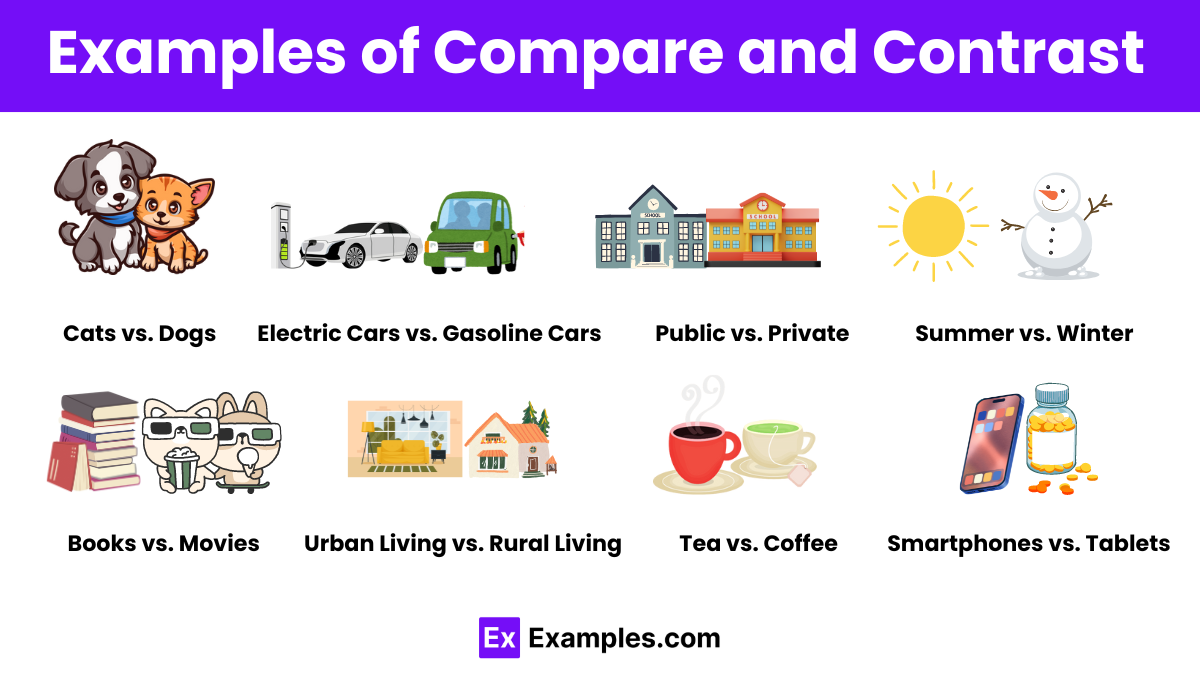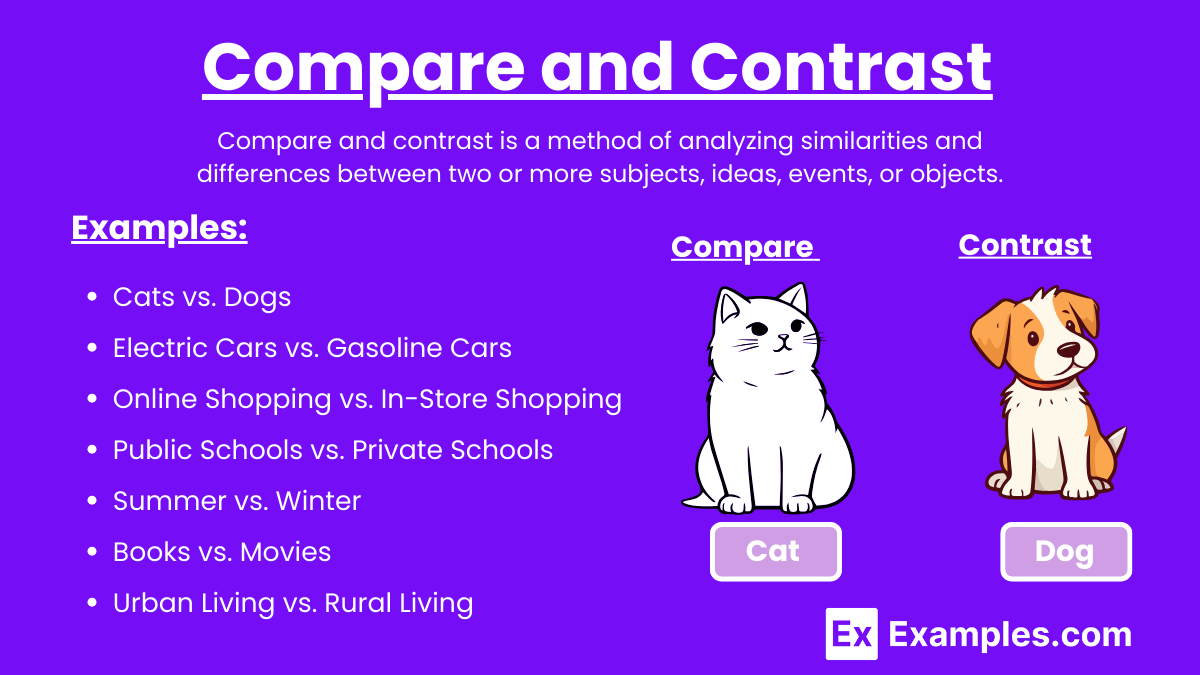40+ Compare and Contrast Examples
Compare and Contrast is a method to examine similarities and differences between subjects, ideas, or objects. By identifying commonalities and divergences, this approach deepens understanding and highlights unique qualities. It’s essential in literature, education, and science, fostering critical thinking and analysis. This technique is frequently used in Compare Contrast Essay, Comparison Contrast Essay, and Comparative Essay writing.
What is Compare and Contrast?
Compare and contrast is a method of analyzing similarities and differences between two or more subjects, ideas, events, or objects. This technique is commonly used in writing, particularly in essays and research papers, to help readers understand relationships between items being compared.
Examples of Compare and Contrast

- Cats vs. Dogs
- Similarity: Both are popular pets and can provide companionship.
- Difference: Cats are more independent, while dogs require more attention and exercise.
- Electric Cars vs. Gasoline Cars
- Similarity: Both are used for personal transportation.
- Difference: Electric cars use batteries and are more environmentally friendly, while gasoline cars run on fossil fuels and have a wider range.
- Online Shopping vs. In-Store Shopping
- Similarity: Both allow consumers to purchase goods and services.
- Difference: Online shopping offers convenience and a broader selection, while in-store shopping allows for physical inspection of products.
- Public Schools vs. Private Schools
- Similarity: Both provide educational opportunities for students.
- Difference: Public schools are funded by the government and free for students, while private schools charge tuition and may offer specialized programs.
- Summer vs. Winter
- Similarity: Both are seasons that bring changes in weather and activities.
- Difference: Summer is typically hot with longer days, while winter is cold with shorter days.
- Books vs. Movies
- Similarity: Both can tell stories and provide entertainment.
- Difference: Books require imagination and are often more detailed, while movies provide visual and auditory experiences.
- Urban Living vs. Rural Living
- Similarity: Both offer unique lifestyles and community structures.
- Difference: Urban living is characterized by a fast-paced environment with more amenities, while rural living is quieter with more open space and nature.
- Mac vs. PC
- Similarity: Both are types of personal computers used for various tasks.
- Difference: Macs are known for their sleek design and user-friendly interface, while PCs offer more customization options and are generally more affordable.
- Bicycles vs. Motorcycles
- Similarity: Both are two-wheeled vehicles used for transportation.
- Difference: Bicycles are human-powered and environmentally friendly, while motorcycles are motor-powered and faster.
- Tea vs. Coffee
- Similarity: Both are popular beverages enjoyed worldwide.
- Difference: Tea is often lighter and has less caffeine, while coffee is stronger and more stimulating.
- Social Media vs. Traditional Media
- Similarity: Both are used to disseminate information and connect with audiences.
- Difference: Social media is interactive and allows real-time engagement, while traditional media is one-way and has a longer production cycle.
- Smartphones vs. Tablets
- Similarity: Both are portable electronic devices used for communication and entertainment.
- Difference: Smartphones are more compact and used primarily for calls and messaging, while tablets have larger screens and are better for media consumption.
- Fiction vs. Non-Fiction
- Similarity: Both are literary genres found in books and other media.
- Difference: Fiction is based on imaginative storytelling, while non-fiction is based on factual information and real events.
- Traditional Classes vs. Online Classes
- Similarity: Both aim to educate students and follow a curriculum.
- Difference: Traditional classes require physical attendance, while online classes can be attended remotely.
- Cooking at Home vs. Dining Out
- Similarity: Both provide meals and can be enjoyable experiences.
- Difference: Cooking at home is often cheaper and allows for customization, while dining out offers convenience and a wider variety of dishes.
Compare and Contrast Examples Sentences
- Jeans are casual and durable, while dress pants are formal and suitable for professional settings.
- Coffee is strong and energizing, while tea is lighter and often calming.
- Hiking offers scenic views and varied terrain, while running is typically done on flat surfaces and focuses more on cardiovascular fitness.
- Paperback books provide a tactile reading experience, whereas e-books are portable and can store thousands of titles.
- Pizza is typically enjoyed as a slice with various toppings, while pasta comes in many shapes and is often served with a variety of sauces.
- Credit cards allow for borrowing money up to a limit, while debit cards withdraw directly from your bank account.
- Football involves strategic plays and physical contact on a large field, while basketball is fast-paced with constant movement on a smaller court.
- Morning routines set the tone for the day and often include exercise, while evening routines help unwind and prepare for sleep.
- Reading involves visual engagement with text, while abooks allow for auditory learning and can be enjoyed while multitasking.
- SUVs offer more cargo space and off-road capability, while sedans are typically more fuel-efficient and easier to maneuver.
- Public transportation reduces environmental impact and is cost-effective, while personal vehicles provide convenience and flexibility.
- Yoga focuses on flexibility and mindfulness, whereas Pilates emphasizes core strength and controlled movements.
- Baking is done indoors and often involves precise measurements, while grilling is typically done outdoors and allows for more improvisation.
- Classical music is known for its orchestral arrangements and complexity, while rock music is characterized by electric guitars and a strong beat.
- Laptops are portable and ideal for on-the-go use, while desktops offer more power and easier upgrades for stationary use.
Comparison and Contrast Examples Paragraph
- City Life vs. Country Life: City life offers vibrant cultural activities and numerous job opportunities, whereas country life provides tranquility and a close connection to nature.
- Online Learning vs. Traditional Classroom Learning: Online learning offers flexibility and convenience, while traditional classroom learning provides face-to-face interaction and a structured environment.
- Public Transportation vs. Driving a Car: Public transportation is cost-effective and eco-friendly, whereas driving a car offers privacy and the convenience of traveling on your own schedule.
- Reading Books vs. Watching Movies: Reading books allows for deeper engagement with the text and imagination, while watching movies offers a visual and auditory experience that can bring stories to life quickly.
- Mac vs. PC: Macs are known for their sleek design and user-friendly interface, whereas PCs are praised for their versatility and compatibility with a wide range of software.
Comparison and Contrast Examples for Essays
- Comparison of Two Historical Periods:
- Compare and contrast the Renaissance and the Enlightenment in terms of their cultural impact and intellectual developments.
- Comparison of Two Literary Works:
- Compare and contrast the themes of love and sacrifice in Shakespeare’s “Romeo and Juliet” and Emily Brontë’s “Wuthering Heights.”
- Comparison of Two Political Systems:
- Compare and contrast democracy and authoritarianism, focusing on their governance structures and impact on individual rights.
- Comparison of Two Educational Approaches:
- Compare and contrast traditional classroom learning with online education, analyzing their effectiveness, accessibility, and learning outcomes.
- Comparison of Two Business Strategies:
- Compare and contrast traditional marketing strategies with digital marketing techniques, examining their reach, cost-effectiveness, and audience engagement.
These topics can provide a solid foundation for discussing similarities and differences, allowing for a thorough analysis and exploration in your essays.
Comparison and Contrast thesis Statement Examples
- Smartphones vs. Traditional Phones: Smartphones offer multifunctional capabilities and instant access to information, whereas traditional phones are simpler and primarily used for voice communication.
- Fast Food vs. Home-Cooked Meals: Fast food is convenient and time-saving, while home-cooked meals are healthier and allow for more control over ingredients.
- Public School vs. Private School: Public schools offer diverse environments and are funded by the government, whereas private schools often provide smaller class sizes and specialized curriculums at a higher cost.
- Books vs. Movies: Books allow for deeper exploration of characters and plot, while movies provide a visual and auditory experience that brings stories to life quickly.
- Summer vs. Winter Vacations: Summer vacations often include outdoor activities and beach trips, while winter vacations focus on indoor entertainment and winter sports.
Difference between Compare and Contrast
Here’s a comparison table outlining the differences between “Compare” and “Contrast”:
| Aspect | Compare | Contrast |
|---|---|---|
| Definition | Highlighting similarities between two or more subjects. | Pointing out differences between two or more subjects. |
| Focus | Emphasizes commonalities. | Emphasizes differences. |
| Purpose | To show how things are alike. | To show how things are different. |
| Structure | Often uses comparative phrases like “similarly,” “also,” etc. | Uses contrasting phrases like “however,” “on the other hand.” |
| Outcome | Enhances understanding of shared traits. | Enhances understanding of distinctions. |
| Example | Comparing the features of two smartphone models. | Contrasting the political ideologies of two leaders. |
| Tool | Venn diagrams are commonly used. | Tables or lists can be effective. |
Importance of Compare and Contrast
Compare and contrast is an essential cognitive process and academic skill that serves several important purposes:
- Critical Thinking Development: Engaging in comparison and contrast requires students to analyze information, identify similarities and differences, and make reasoned judgments. This process promotes critical thinking by encouraging deeper analysis rather than surface-level understanding.
- Enhanced Understanding: Comparing and contrasting helps clarify concepts and ideas by highlighting their similarities and differences. This method deepens understanding by forcing students to examine details, contexts, and implications.
- Promotion of Higher Order Skills: It encourages the development of higher-order thinking skills such as analysis, synthesis, and evaluation. These skills are crucial for academic success and lifelong learning.
- Effective Communication: The ability to compare and contrast effectively enhances communication skills. Whether in writing or verbal discussions, this skill allows individuals to articulate their ideas clearly and persuasively, drawing on structured comparisons to support their arguments.
- Decision-Making and Problem-Solving: Comparing options and contrasting their attributes is fundamental to effective decision-making and problem-solving in various contexts, from personal choices to professional strategies.
- Promotion of Diversity and Tolerance: By examining similarities and differences among cultures, beliefs, and perspectives, comparison and contrast foster empathy, tolerance, and appreciation for diversity.
FAQ’s
How do you structure a compare and contrast essay?
Start with an introduction, followed by body paragraphs comparing and contrasting, and end with a conclusion.
What are some compare and contrast essay topics?
Examples include comparing two books, historical events, or different theories.
What words signal a compare and contrast structure?
Words like “similarly,” “on the other hand,” and “however.”
What is the purpose of using a Venn diagram?
It visually represents similarities and differences between two or more subjects.
What is the difference between compare and contrast?
Comparing focuses on similarities; contrasting focuses on differences.
What are some strategies to organize a comparison?
Use point-by-point or subject-by-subject methods.
What are the benefits of using compare and contrast in education?
It aids in understanding complex topics and developing analytical skills.
What is a compare and contrast paragraph?
It discusses similarities and differences between two or more subjects in a concise format.
How do you avoid bias when comparing and contrasting?
Present facts objectively and consider multiple perspectives.
What are some common pitfalls in compare and contrast essays?
Overemphasizing similarities or differences without critical analysis.



